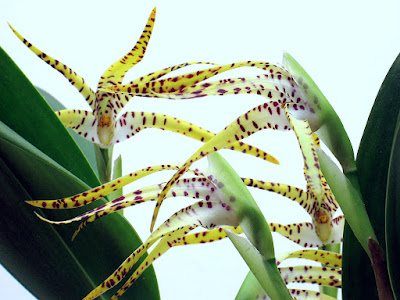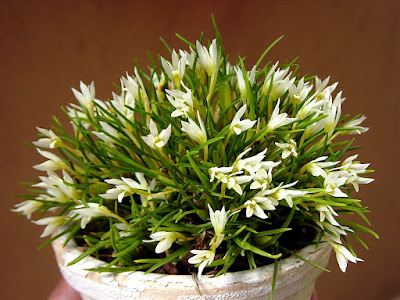Maxillaria orchid -Tiger orchids flower size ranges broadly from 1.25 cm to over 15 cm in diameter with free petals and sepals that have...
Maxillaria, also called as tiger orchids, Adamanthus, Anthosiphon, Aucellia, Bolbidium, Brasiliorchis, Calawaya, Camaridium, Chaseopsis, Chelyella, Christensonella, Chrysocycnis, Cryptocentrum, Cyrtidiorchis, Cyrtidium, Cyrtoglottis, Dicrypta, Heterotaxis, Hoehnella, Hylaeorchis, Inti, Laricorchis, Mapinguari, Marsupiaria, Maxillariella, Menadena, Mormolyca, Neo-urbania, Nitidobulbon, Ornithidium, Pittierella, Pityphyllum, Pseudocymbidium, Pseudomaxillaria, Psittacoglossum, Rhetinantha, Sauvetrea, Sepalosaccus, Siagonanthus, Trigonidium, Vazquezella, Viracocha, Xanthoxerampellia, is a genus in the Orchidaceae family. This genus was described by Hipólito Ruiz López and José Antonio Pavón Jiménez in 1794.
DESCRIPTION OF MAXILLARIA ORCHID - TIGER ORCHIDS
Maxillaria orchid is native to tropical and subtropical America. It is found growing in Argentina Northeast, Belize, Bolivia, Brazil North, Brazil Northeast, Brazil South, Brazil Southeast, Brazil West-Central, Central American Pac, Colombia, Costa Rica, Cuba, Dominican Republic, Ecuador, El Salvador, Florida, French Guiana, Guatemala, Guyana, Haiti, Honduras, Jamaica, Leeward Is., Mexico Central, Mexico Gulf, Mexico Northeast, Mexico Northwest, Mexico Southeast, Mexico Southwest, Nicaragua, Panamá, Paraguay, Peru, Puerto Rico, Suriname, Trinidad-Tobago, Venezuela, Venezuelan Antilles, Windward Is. in the rainforest at sea level to elevations of 3500 meters above sea level.
The species of this genus are mostly epiphytes, rather large in size, but some are terrestrials or even lithophytes with very short to elongate, creeping, ascending or suberect rhizome which is clothed in a somewhat transparent, silvery-gray velamen. Their pseudobulbs are round or oblong and each carry usually one leaf but some species have up to four lanceolate leaves. Some grow close together in a clustered manner on the rhizome, while in other species the pseudobulbs keep some distance on the rhizome.
Tiger orchids bloom from the one flowered inflorescences with some species producing clusters of inflorescences from the base of each individual pseudobulb. The flower size ranges broadly from 1.25 cm to over 15 cm in diameter and never longer than the leaves with free petals and sepals that have a typically curved and adnate labellum with three inconspicuous lobes or an entire lip with a distinct callus on the disc and has 4 waxy pollina.
MAXILLARIA ORCHID - TIGER ORCHIDS CARE AND CULTURE
Cultural information should only be used as a guide, and should be to be adapted to suit you. Your physical location; where you grow your plants, how much time you have to devote to their care, and many other factors, will need to be taken into account. Only then can you decide on the cultural methods that best suit you and your plants.
Light:
Maxillaria orchid needs a light level of 18000-25000 lux. Moderately bright light should be filtered or dispersed, the plants should never be exposed to the direct effects of the midday sun. The strong air movement should be ensured at all times.
Temperature:
The plants of this genus grow well under intermediate temperatures. The average temperature of the summer day is 23-25 °C, night 14-16 °C with daily amplitude of 8-9 °C. In winter, the average day temperatures are 17-18 ° C, and the night around 10 ° C with the daily amplitude of 7-8 ° C.
Humidity:
Tiger orchids needs the humidity of about 70-80% for most of the year. Too dry air has a negative effect on the development of the plant: its growth is inhibited, and the leaves begin to turn yellow and dry out. The higher temperature, the higher the humidity should be, and the higher the humidity, the more often and longer it is necessary to ventilate the room where the plants are contained, otherwise the probability of rotting and various kinds of fungal diseases. Good air movement is essential while the plants are in leaf and growing.
Substrate, growing media and repotting:
Maxillaria orchid can be grown both in pots with good drainage as well as mounted on a piece of cork oak or tree fern. However, it should be remembered that in the second case the plants require high humidity, and during hot and dry weather it may be necessary to water several times each day.
For this reason, it is easier to grow in pots or hanging baskets filled with very loose, quickly drying substrate. The most commonly used growing medium is medium-sized fir bark or shredded tree-fern fiber with the addition of coarse pearlite to keep the substrate cool while providing the right amount of moisture. The addition of charcoal also has a positive effect on the structure of the substrate and prevents its acidification.
The plants should be repotted immediately if the substrate is decomposing or when the pot is too small. Repotting is best done at the time of emergence of new roots, which guarantees that the plant will regenerate its strength in the shortest possible time.
Watering:
Tiger orchids should be watered frequently while they are actively growing, but there should be excellent drainage and the roots need to dry out quickly after watering. When the new growths reach maturity in the fall, the amount of water should be reduced.
Fertilizer:
During the period of active growth, the plants should be fertilized every week with 1/4-1/2 doses of fertilizer for orchids. You can use sustainable fertilizer throughout the year, but also can use a high nitrogen fertilizer from spring to mid summer, then in late summer and autumn use fertilizer with a predominance of phosphorus.
Rest period:
Maxillaria orchid usually does not need a rest period in winter, expect some species, and such conditions should be maintained throughout the year. In winter, the amount of water should be reduced somewhat, especially if the plants are grown in cooler conditions, or in the darker, short day conditions, but the plants should never be completely without water. Fertilization should be reduced or eliminated until new growths appear and watering begins more abundantly in the spring.
BUY MAXILLARIA ORCHID - TIGER ORCHIDS AND RELATED PRODUCTS:
SOME SPECIES AND VARIETIES OF MAXILLARIA WITH CARE TIPS:
- Maxillaria acervata - Bundled Maxillaria
- Maxillaria aciantha - Pointed Flower Maxillaria
- Maxillaria alba - White Flowered Maxillaria
- Maxillaria anceps - Double-Edged Maxillaria
- Maxillaria angustisegmenta - Narrow Segmented Maxillaria
- Maxillaria angustissima - Narrowest Maxillaria
- Maxillaria brachybulbon - Short-Bulbed Maxillaria
- Maxillaria caespitifica - Mat-Forming Maxillaria
- Maxillaria cobanensis - Coban Maxillaria
- Maxillaria confusa - Confounded Maxillaria
- Maxillaria cucullata - The Cowl Carrying Maxillaria
- Maxillaria curtipes - Short-Column Maxillaria
- Maxillaria densa - Crowded maxillaria
- Maxillaria diuturna - Long-Living Maxillaria
- Maxillaria elatior - Sturdy Maxillaria
- Maxillaria friedrichsthalii - Friedrichsthal's Maxillaria
- Maxillaria fulgens - Shiny Maxillaria
- Maxillaria grandiflora - The Large-Flowered Maxillaria
- Maxillaria hedwigiae - Hedwig's Maxillaria
- Maxillaria hematoglossa - Blood Red Lipped Maxillaria
- Maxillaria longissima - The Longest Petal Maxillaria
- Maxillaria maleolens - Foul Smelling Maxillaria
- Maxillaria mombachoensis - Mombacho Maxillaria
- Maxillaria nasuta - Nosed Maxillaria
- Maxillaria neglecta - Neglected Maxillaria
- Maxillaria oreocharis - Mountain Loving Maxillaria
- Maxillaria pachyacron - Narrowest Maxillaria
- Maxillaria paleata - Shovel-Shaped Maxillaria
- Maxillaria picta - The Painted Maxillaria
- Maxillaria porrecta - Extended Maxillaria
- Maxillaria praestans - Outstanding Maxillaria
- Maxillaria ramonensis - San Ramon Maxillaria
- Maxillaria reichenheimiana - Reichenheim's Maxillaria
- Maxillaria ringens - Rigid Maxillaria
- Maxillaria rufescens - Light Fox-Red Maxillaria
- Maxillaria sanguinea - Blood-Red Maxillaria
- Maxillaria schlechteriana - Schlechter's Maxillaria
- Maxillaria sigmoidea - S Shaped Lip Maxillaria
- Maxillaria sophronitis - The Sophronitis-Like Maxillaria
- Maxillaria tenuifolia - The Coconut Orchid - The Delicate Leafed Maxillaria
- Maxillaria uncata - The Hook Shaped Maxillaria
- Maxillaria variabilis - The Variable Maxillaria







.jpeg)









COMMENTS